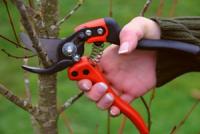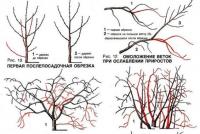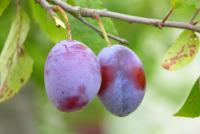Botanical characteristics of roses. Ceramic Floristics Workshop: Leaves, Stem and Rose Tinting
in ornamental floriculture the name of the cultural forms of plants belonging to the genus Rosehip (lat. Rósa) family Pink. Most of them are shrubs 1-2 m tall with erect or slightly drooping branches. There are species with very long, creeping on the ground or clinging to the trunks and branches of neighboring plants, climbing to a considerable height shoots. Some grow in the form of thick, low bushes - pillows, very decorative during flowering. Leaves are pinnate, with elliptical or ovate, sharply serrate leaves, with two leaf-like stipules, partially adhered to the base of the leaf stem. The flowers are large, fragrant, bisexual, solitary or gathered in inflorescences. Sizes of flowers from 1 to 12 cm in diameter.
Sepal 5.Venchik svolopodnovestnaya, formed, as a rule, five reversal azerdtsevidnymi petals of pink, red, dark crimson, white or yellow.
According to archaeologists, the rose on Earth already exists for about 25 million years, but in culture it has been grown for more than five thousand years and for a longer period this rose was considered a real sacred symbol, the fragrance of which has always been associated with something divine.
The first mention of the cultivation of roses in Russia dates back to the beginning of the XVI century. It is assumed that they came to Russia through the Balkan Slavic tribes. Mass distribution received only under Catherine II. By the end of the XIX century, roses began to grow throughout the European part of Russia.
These are easily cultivated plants, they are widely used in green construction, in particular, when creating soil-protective plantings. Drought-resistant and undemanding to soil conditions.
Most species are light-requiring, grow well on moderately moist, loamy soils, do not tolerate excessive moisture. Propagated by seeds and vegetatively - when breeding the so-called park roses, the most decorative species dog roses and their garden forms with double flowers.
Garden forms are also propagated by dividing the bush, offspring, layering, stem and root cuttings, varieties of cultivated roses - grafting. Roses - plants are warm and light-loving, so when planting a place for them is chosen open, lit by the sun and protected from cold winds.
Inadmissible stagnation of cold air, as well as irrigation and melt water, upper water. Groundwater deposition should be no higher than 1-1.5 m. Excess moisture is removed with the help of drainage devices.
Medical applications
Healing properties roses have been known since ancient times. However, at present, Western medicine makes little use of the rose, while in the East the attitude towards it has not changed. In the Middle Ages, a huge number of diseases were treated with a rose: menstrual disorders, headache, gastric disorders, liver congestion, fever (plague), eye infections and skin diseases.
Location
Roses - plants are warm and light-loving, so when planting a place for them is chosen open, lit by the sun and protected from cold winds. Inadmissible stagnation of cold air, as well as irrigation and melt water, upper water. Groundwater deposition should be no higher than 1-1.5 m. Excess moisture is removed with the help of drainage devices.
Starting the cultivation of garden roses, you need to know the properties of wild roses, which are commonly called wild roses. We bring to your attention a fragment of the book of Lyubov Bumbeeva "Roses".
Garden roses are a product of centuries-old culture. They are created by man as a result of a long and complex process of improving some species of wild roses. This process continues today, as all new species are gradually drawn into the culture, new garden groups appear, the range of garden roses is growing. Starting the cultivation of garden roses, you need to know the properties of wild roses, which are commonly called wild roses. Wild roses are widespread in cold and temperate zones.
Roses belong to the botanical genus Rosa, numbering more than 300 species, and belong to the Rosaceae family.
Typical morphological features of the genus Rosa include:
- shape, size of the bush, its characteristics;
- length direction and color of the shoots;
- shape, size, location and color of thorns;
- the shape, size, color and texture of the leaves;
- shape, size and color of the bud;
- the shape, size, color and terry of the flower;
- its shape in the open state;
- arrangement, shape of petals and sepals;
- the location and number of flowers on flowering shoots;
- characteristic signs of smell;
- time and features of flowering;
- shape, size and color of fruits.
Bushes
In natural habitats, roses are deciduous or evergreen shrubs and shrubs with a height of 15 cm to 3 m and above, some species with long (up to 7-9 m), thin, creeping along the ground or clinging to the support shoots. All roses in the form of a bush are divided into bush and climbing. Typical bush forms have well-known species roses: R. canina, R. cinnamomea, R. centifolia, R. rugosa, form bushes of two or more meters in height. To undersized bushes are miniature roses. Some species of rose hips do not develop erect, but very long, creeping shoots along the ground. It looks like an evergreen rose (R. sempervirens), plowed rose (R. arvensis). The shrubs of these roses are shaped like large flat “rosettes”, which are very decorative during their mass flowering. A number of species have the ability to cling to their long shoots, spikes on the trunks and branches of neighboring trees and climb to a considerable height.
The density of the bush is determined by the presence of lateral shoots. Types of branching bushes are distinguished:
- dense branching of all shoots directed in different directions, shoots are short, strong (park roses);
- branches on skeletal shoots are short and thin (teas and hybrid, floribunda)
- secondary shoots are short (but longer than those of parks), strong (remontant roses, scrubs).
The color of the shoots of roses is different. On young shoots, the bark is green, reddish or purple, especially from the sunny side. By autumn, the color fades. (Fig. Bushes).
Spikes
Shoots are usually covered with thorns of various shapes and sizes. Thorns are a special formation of the covering fabric of the shoots of roses and serve as an excellent natural protection of plants. In park, except for thorns, often there are formations in the form of spines, setae or hair-like formations. Some species and varieties of R. canina ‘Inermis’, R. banksiae, Bengal roses are almost devoid of thorns. Spikes vary in size, shape, color.
The shape of the spikes are:
- straight lines (R. rugosa, R. stellata, R. foetida)
- arc-shaped (from Bengal roses)
- hooked-curved, sometimes thickened at the base (R. multiflora, R. muscosa)
- triangular (R. zweginzowii)
- awl-shaped (R. foetida, R.villosa)
- pterygoid (R. sericea pteracantha)
- bristle-like (R. rugosa, R. gallica)
Sometimes on the same shoot, thorns are different in shape. In garden roses, thorns are more often hook-shaped. The color of the spines varies, and therefore cannot be considered as a typical feature. Nevertheless, R. rugosa, R. foetida is grayish, R. rubiginosa, R. pimpinellifolia has brown-rusty, R. banksiae has greenish-bronze, many tea roses have purple, hybrid tea roses, floribunda - mostly green in various shades. In some species of wild rose thorns are very decorative and visible from a distance. The most unusual thorns in the pteracantha rose (R. omeiensis pteracantha) are wide and pterygoid at the base, transparent red.
Leaves
Leaves - alternate, pinnate (complex). Almost all wild roses have a leaf size smaller than garden roses. A leaf consists of 3-5, 5-7, 9-11, 13 or 15 leaflets attached to a common petiole. At the base of the stem there is a stipule adherent to it. The number, size and shape of leaflets and stipules serve as a characteristic feature of certain types of roses. Small leaves in R. pimpinellifolia, R. lawranceana, large in R. macrophylla, in garden roses, the average size of the leaves dominates. The shape of the leaves is mainly determined by the ratio of length and width. Variety is observed within the oval type. Leaflets are pubescent (in old varieties) and bare on both sides (in most modern ones). The leaves of the rose rust (R. rubiginosa) have special pieces of iron that emit an essential oil that has a pleasant aroma that resembles the smell of fresh apples.
The color of the leaves varies within the basic green color, but in roses from different groups it is specific. By coloring the leaves are: light green, green, dark green. Young leaves of many varieties of roses - bronze or purple. The texture of the leaves are distinguished: matte, semi-matte, shiny, semi-shiny, leathery. Many modern varieties have shiny leaves, wild ones have no shine (except for R. canina, R. bracteata, R. wichurana). Glitter gives decorative leaves to roses and for some groups is a morphological feature. Roses with shiny leaves are less affected by fungal diseases. In most wild rose species, after the end of the development cycle, the leaves fall off. In modern varieties with the onset of cold weather, the vegetation stops, and the leaves are kept on the bush.
Inflorescences
Flowers in roses are single-flowered - single, few-flowered - several together (2-3 flowers) or many-flowered (from 5 and more) - in the form of thick umbrella-shaped paniculate inflorescences, consisting of a mass of flowers. According to the arrangement of the flowers, the inflorescences are corymboid-umbrella-shaped, pyramidal-umbrella-shaped, paniculate.
Buds
The shape of the buds are distinguished: rounded, ovate, rounded-pointed, elongated-pointed, ovate-elongated. Park roses have mostly rounded and rounded-pointed buds, smaller in size than modern roses.
Flowers
Flowers - bisexual. Inside the flowers are clearly visible numerous pistils and stamens, which are located at the bottom of the thickened receptacle. Growing, the receptacle becomes fleshy and, together with the stamens and pistils, forms a false fruit. The real fruits are single-seeded nuts, enclosed in a fleshy, growing receptacle. False fruits in practice are called fruits, and real fruits are called seeds.
The largest flowers are: large (10-16 cm in diameter), medium (6-9 cm) and small (less than 6 cm). 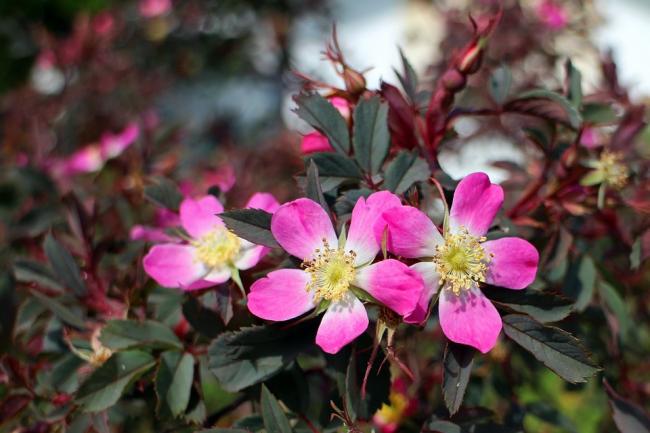
Depending on the number of petals, flowers may be: simple (the number of petals is 5), semi-double (10 to 20), arranged in 2-4 rows of 5 each; double (from 20 to 50) - in 5-8 rows and densely double (the number of petals is from 50 and more) - 8 and more rows of petals, and the middle of the flower is filled with a compact mass of small petals. In some varieties, flowers bloom quickly, others gradually (terry and gustomahrovye varieties).
Regardless of the degree of terry, petals are narrow, broadly heart-shaped; length equal to the maximum width, wide and rounded. According to the consistency of the petals are distinguished dense, thick and soft thin.
A typical wild rose flower consists of 5 leaf-shaped sepals and 5 petals, with the exception of R. sericea - 4. Sometimes in some species there are flowers with a greater number of petals. Part of the stamens and pistils at the same time turns into additional petals. Thus, there are semi-double and double flowers. In some cases, the number of new petals grows to a very large number, so that there are almost no normally developed stamens and pistils in the flower. For example, a centiphal or table-shaped rose (R. centifolia) has up to 100 or more petals, double-shaped rose wrinkled (R. rugosa) forms up to 180 petals. In terry varieties, the ability of flowers to pollinate and abundant fruiting is reduced.
The shape of the flower depends on the density, shape and size of the petals. In terry roses, the outer petals are always larger than the inner ones. Flowers in shape can be:
flat - when opened, the flower is flat or with a slightly deeper surface;
cupped - the flower has a depression towards the center, the outer petals are higher than the inner ones, with the edges bent outwards;
goblet with high center - flowers are rounded, with a spiral arrangement of the petals, ensuring their gradual opening, the outer petals are large, concave;
spherical - the flowers are more or less rounded, the outer petals are large, concave;
square - arrangement of petals by sectors from the center (4 or 5 sectors) with densely lying petals;
tiled - petals with edges bent outward resemble folded tiles, flowers slightly convex;
bent - the bud does not open for a long time; when blooming, the petals spiral outwardly bend outwards.
These are the main forms of the flower, but some forms of modern roses require additions to these descriptions.
Flower color is the most diverse in modern roses. The color scale is achieved as a result of numerous crosses. In wild roses, red (light tones) and pink color prevail, white and yellow are very rare, and lilac is absent.
Aroma
The aroma of flowers varied: strong, medium, weak. In most wild species, flowers have a pleasant aroma: honey (R.rugosa), apple (R. rubiginosa), fruit (R. centifolia, R. gallica, R. muscosa), less often unpleasant (R. foetida). Chinese roses have a tea flavor. Most modern varieties have more or less fragrant flowers.
Bloom
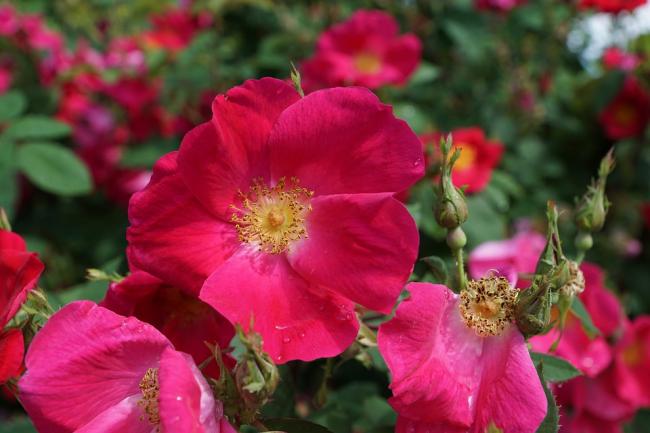
Bloom. By the nature of flowering roses are divided into single-flowering and re-flowering. The flowering of most species of wild roses occurs on last year's shoots wood. Flower buds are laid in the year preceding flowering. Wild roses bloom first (in May), but bloom once and for a relatively short time (15-25 days). Vintage garden roses begin to bloom later species (in May - June), bloom also once, and only some have re-bloom, weaker than the first. Roses of modern breeding (hybrid tea, floribunda groups, scrubs, large-flowered, miniature, polyanthus roses) bloom at the end of June, blooming twice to frost.
Fruit
Fruit. Pollination in roses mainly occurs with the help of insects or wind. Due to the transformation of stamens and pistils into additional petals, the ability of the flowers to pollinate and abundant fruiting is reduced. Sometimes the flowers remain barren, as for example in the centifolia rose (R. centifolia). 
Many wild species roses are valued in ornamental gardening precisely because of the abundance and beauty of fruits. By size, the fruits are divided into large, medium, small, and in shape into round (R. pomifera), flat (R. rugosa rubra), pear-shaped (R. holodonta), ovate (R. eglanteria), etc. By color, they are distinguished: red (R. rugosa alba), orange (R. bracteata), black (R. pteragonis).
The root system of most roses lies superficially, extending from the root collar almost horizontally. So develops root system Cinnamon rose (R. cinnamomea), rust rose (R. rubiginosa), and others. Roza canina (R. canina), which is one of the best rootstocks for the middle zone, has a very strong root system that goes down to 2 m or more. . The most frost-resistant species is the spiny rose (R. acicularis).
In addition to the complex morphological features, they are essential biological features: flower color fastness, heat resistance, disease resistance, winter resistance, flowering abundance, compatibility with the rootstock, etc.
Sometimes there is a very interesting phenomenon in rose flowers - proliferation. It consists in the fact that a vegetative shoot grows over the flower, completing the new one, a little more small flower. A flower forms a second tier.
Varieties of garden roses for seed reproduction do not pass on all their qualities. In order to preserve them, the variety is propagated only vegetatively: by budding or grafting.
The aroma of flowers of most species of roses due to the content in their petals of essential rose oil. Rose oil is one of the most expensive in the world. The famous Kazanlak rose (Bulgaria) is especially famous for its aroma and high oil content in the petals. It serves as a raw material for the industrial production of rose oil. To obtain 500 g of pure oil, 500 kg of petals must be processed.
The aroma of roses is very diverse and, as a rule, pleasant: it is the aroma of honey, tea, violets, fruits. Up to 25 types of rose smell are known. 75% of all roses have a scent. But there are roses with an unpleasant, intoxicating scent, for example, the rose of Thetid Persian (R. foetida persiana).
All roses are shrubs. Standard rose - “tree-rose”, which is not created by nature, it is subject to make only the gardener.
The fruits of wild roses contain from 3 to 17, 5% of vitamin C (ascorbic acid), as well as vitamins B2, K, provitamin A. Especially prized fruits of cinnamon rose (R. cinnamomea). Often fruits have sweet pulp and therefore are used for making preserves, stewed fruit, etc.
Lyubov Ivanovna Bumbeeva accompanies the Green Arrow's trips, whose main focus is on roses.
You will find a list of such trips.
You can see the full list of Green Arrow travels.
Add site to bookmarks
How to recognize the leaves of a rose: the main differences from the wild rose
- How to distinguish two similar shrubs?
- Dogrose description
- Nine types of roses
The leaves of the rose indicate that they belong to the Rosaceae group, to which the wild rose also belongs. Some species of wild rose are wild roses. But in reality, rose and dog rose have a number of differences. We will understand what they are. During the flowering period, you can easily distinguish these two plants. It is enough to pay attention to the leaves of the rose, as well as its petals. The branch has a large number of petals, while the dog rose has only five. It is important to note: a dog rose is a plant that produces healthy fruits, but a rose does not bear fruit, but only pleases with its beauty.
Often confused leaves of rose and wild rose.
In late summer, the difference between the two plants is clearly visible: the dogrose has orange or red berries.
Rose and dog rose need to be distinguished when planting. First look at the shoots. It should be noted that the rose has red shoots, after some time they become green. At the dog rose, they immediately appear green. The leaves of the rose are visible in a small amount, there may be three, a maximum of five, a dogrose has seven, and the top one grows without a pair. The rose leaf is quite solid, large, it has a glossy surface and a dark green color.
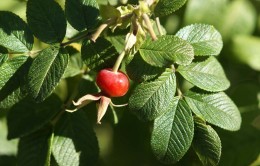
Rosehip leaves have a more matte basis.
As for the leaves of wild rose, they are smaller in size, have a lighter color and a matte surface. The rose has large spikes, unlike those of the wild rose. He is small, more often. A dogrose can have small thorns on a leaf. It often happens that cultivated roses are grafted onto a given plant. Then you may encounter certain difficulties: dogrose takes all the food on itself, the functioning of the rose deteriorates. It is necessary to otgresti layer of soil under the bush to the depth to which the escape grows, then you want to cut rose hips flush with the root. Otherwise, it will branch and instead produce one many shoots.
Back to table of contents
Dogrose description
Consider the features of this shrub. If it grows in a temperate or cold zone, the flowering period is in May - early June. And if it is located in the subtropical zone, it can bloom for a long time, almost all year round. As for the appearance of fruits, the varieties of wild rose, which we are accustomed to encounter, bear fruit in September or August. The shrub has sufficiently strong, fleshy fruit. Inside them are small, but powerful villi, holding the skin. If the dog rose is in free growth, it can be quite large, sometimes reaching a height of 2 m. The bush has branches that stand straight, it seems that they are slightly drooping. It can extend along the ground, touching adjacent trees. When the dog rose begins to bloom, it is literally impossible to take your eyes off of it: the flowers are very beautiful, they can be white, red, crimson.
Cultivated dog roses are called red roses, they are often used in gardening, these plants have a good landscape appearance. One of the most common types of wild rose is a wrinkled rose, or rose rugosa (Rosa rugosa), and hybrids created from it. It has wrinkled leaves and setae along the shoot. Her smell is not as pronounced as in others. Flowering occurs throughout the summer. As for its bushes, they are durable and quite unpretentious, they can be seated both individually and in small groups. The main difference between rose rugoz is frost resistance, it grows throughout the year in Russia.
Most of the negative experiences are really related to hybrid tea roses, but this does not mean that when choosing these roses, you should immediately prepare for the feat. Not every variety that is offered for sale in Russia will please the owner with resistance to mushroom diseases, stable winter hardiness and abundant flowering, but this is only a matter of choosing the right one.
A bit of history of rose
The first hybrid tea rose "La France" appeared in 1867 as a result of accidental interbreeding presumably between varieties of tea rose " MmeBravy" and remontant " MmeVictorVerdier" in the nursery 'Guillot et Fils'. At first, the garden public, accepting repeated and abundant flowering, did not notice the novelty: the silvery-pink, thick and fragrant flowers were beautiful, but they remained in the tradition of the cold garden and did not introduce new warm shades so attractive tea roses. Only two decades later, perhaps thanks to a patriotic name, the time for the glory of the variety in France came, and then world recognition. Adherents of the Bourbons chose her as their emblem: the royalist ladies began to wear gold brooches, and the men pins with the image of a rose. "La France" today is an integral part of the history of rose growing, I will not advise it for each garden, but any collection without it will not be complete.

Rose from which hybrid tea roses begin ("La France", Guillot et Fils, 1867)
Subsequently, the mass crosses of tea and remontant roses gave a wealth of colors, elegance of the bud and flower forms, a wonderful smell. Hybrid tea roses began to quickly replace reparative roses from gardens and flower shops, and since then their popularity has not waned. Despite the fact that in the twentieth century, new classes of modern roses appeared - floribunda and scrubs (including ground cover forms and English roses), we can say that this century did pass under the sign of hybrid tea roses, and incomparable "Mme A. Meilland" ("Peace", "Gloria Day"). This rose will still attract fans from future generations and will remain the highest standard forever.
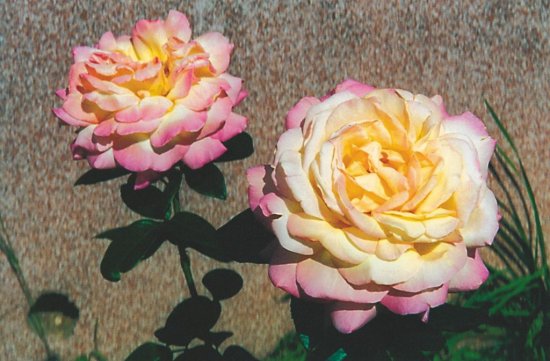
The rose of the twentieth century "Mme A. Meilland", ("Peace", "Gloria Day") will remain the highest standard forever.
What flower buds?
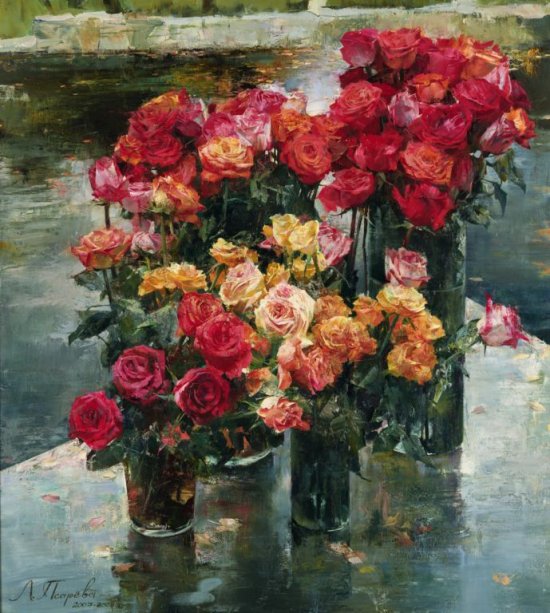
Larisa Psaryova. Shades of water. 2008
Today, you can find a rose of any color that is possible for the culture, so the most important selection criterion is in shape. All the variety of forms of the flower of roses fit into an approximate (schematic) classification, which is based not on quantitative characteristics, but on the similarity of the external shape of the flower with geometric shapes, which already suggests some proportions. For roses are characterized by the following forms of buds (flowers): cone-shaped (goblet), cupped, spherical, rosette, lodged, flat, pompon.
Lovers of roses today are mostly fans of goblet and cup-shaped flowers, although some find their ideals among mysterious spherical or free art forms.
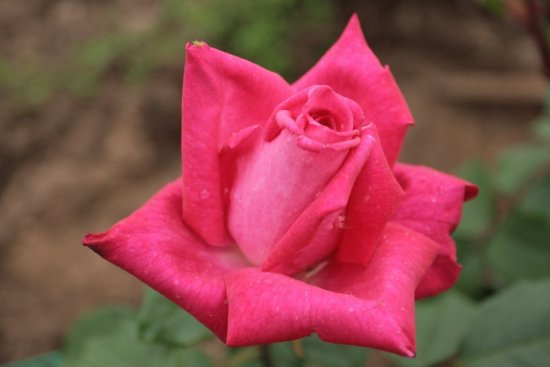
Bud Classic ("Lolita Lempicka", Meilland, 2002)
Conical (goblet) form It is created by laying high internal petals and reflects variations of proportions, when the height of the bud is larger (or significantly larger) than its diameter at the base. The highest degree of elegance is a dense elongated bud with a pointed top like, for example, a variety. ("Lolita Lempicka", Meilland, 2002). This form is called a classic, and many amateurs associate their expectations regarding flower perfection with exactly this form of buds. Although sometimes the ideal conical bud hides not so many petals and blooms into a flower of indefinite (free) form. Some flowers have an amazing symmetry in laying petals. ("Savoy Hotel", Harkness, 1989), others - dense spiral center like a "Impératrice Farah’ (Delbard, 1992).
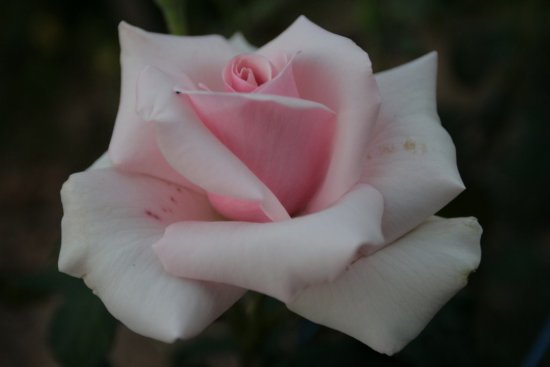
Rose, which can be admired today ("Savoy Hotel", Harkness, 1989)
Cup shape
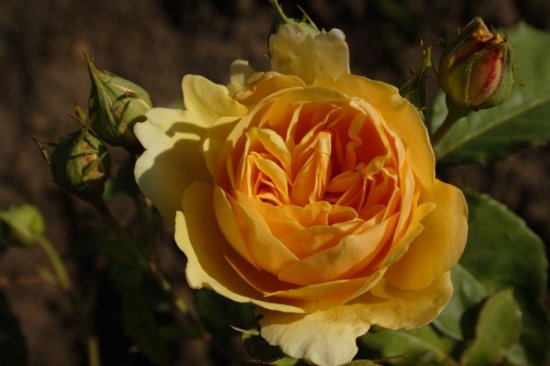
A typical example of an old-fashioned cupped flower ("Candlelight", Rosen Tantau, 2001)
Cup shape flower is formed if the height of the bud is approximately equal to its width at the base. The edges of the flower petals are often bent outward and open the stamens. It is believed that cupped flowers are more feminine and sensual. Flowers with a terry of about 30 petals, opening, can take a flat-cup shape ("Souvenir de Louis Amade", Delbard, 1998), However, this form of supporters is not so much, although, as we know, simplicity does not exclude beauty and elegance.
A wide fashion on the old type of flower with numerous petals gives examples of laying petals in dense roses. Sometimes some orderliness or even symmetry is noticeable, but more often there are options when several outer rows have ordering and the central petals are grouped difficult, intricately or simply closely. (‘ Kordes’ Jubilee’, W. Cordes’ Söhne, 2012; "Piano", RosenTantau, 2007).

Rose "Souvenir de Louis Amade" (Delbard, 1998) on the background of vintage beadwork
Today, there are many supporters of cup-shaped flowers of the old appearance, the boom is associated with the appearance of English roses, but if all the flowers in the garden have only this shape, then this may be a boring decision. A descendant of the famous Guyot family, breeder Dominic Massad, who created a large collection of Generosa varieties with an English type of flower, confessed to us that he was already tired of the monotony of their appearance and is now inspired by the search for new free flower forms.
Spherical shape

Spherical flowers "Madame Figaro" (Delbard, 2000)
Spherical shape flower proportions similar to the cup, as the height is approximately equal to the width at the base, but the petals are curved toward the center and as it protects the stamens. Such forms are not common and introduce an element of intrigue or mystery. (‘ Honoré deBalzac’, Meilland, 1994; " MadameFigaro" , Delbard, 2000; " History", RosenTantau, 2002)
There are varieties in which the shape of the flower can not be estimated by the height, width, volume or number of petals. This is the “fourth dimension” - the impression that the flower produces, I call this form magical. An example of such a form for me the last five years is "Hommage a Barbara "(Delbard, 2004), the rose attracts the eye, and the memory does not find analogies. The special charm is given by the “accessories”: the uneven or dissected edge of the petals, the texture of the “material” itself (silk, satin, velvet), a small wave or a noticeable corrugation of the petal and finally, as a precious decoration, a bouquet of golden stamens. These roses are not always ordinary and, as a rule, are widely known.
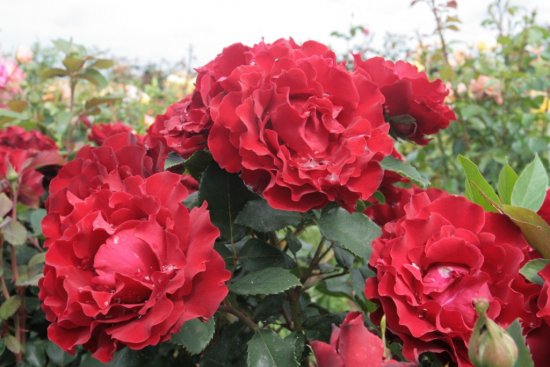
Mysterious and mysterious Hommage a Barbara (Delbard, 2004)
Attract color and shape, but you also want flavor
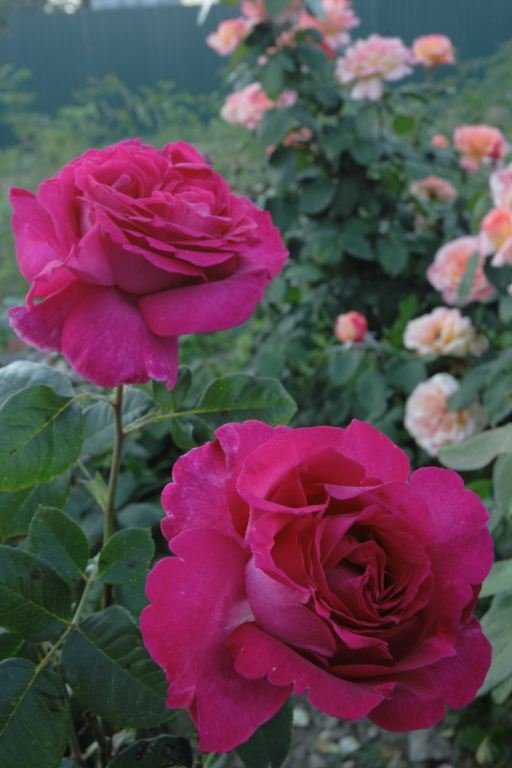
"Chartreuse de Parme" (Delbard, 1996) left its mark on perfumery
Not every smell garden rose, and strong aroma is rare. The reason for this in life is explained simply and humanely: breeders do not produce fragrant roses, because not all people tolerate odors without health consequences. In fact, this is explained even more simply: the fragrance is a sign of a recessive (from Lat. Recessus is a digression), it may not manifest itself in the progeny. Often, the descendants of even fragrant roses had no smell at all. The aroma was perceived by the breeders as luck, a reward for work and patience. Recently, with the development of genetic engineering and biotechnology, it is possible to regulate this complex trait. So, the Delbard company is considering the possibility of including the flavor in the breeding program.
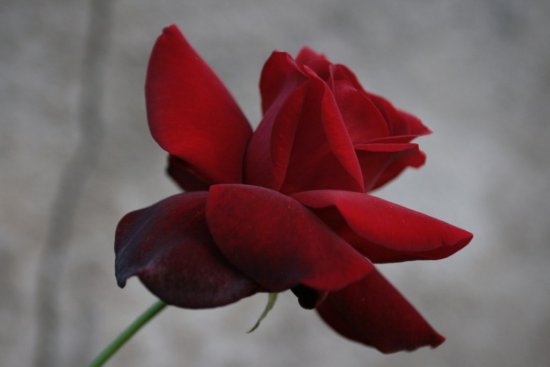
The elegant flower with a strong smell of vanilla "Le Rouge et le Noir" (Delbard, 1973) can be included in the thematic collection of "black roses".
Every lover of roses is associated not only with beautiful flowers of perfect shape, but also with some favorite and recognizable scents, the collection of which is accumulated in the memory. Not all of us have “sensitive noses,” and the ability to smell is subjective. The “piggy banks” of smells are different for different people, each forming its own standards. Modern physiologists point out that there are no two people with the same perception of flavor, this is also the essence of our genes.

Collection variety, favorite rose of the world - 1981 "Duftwolke" (Rosen Tantau, 1963) with an incomparable aroma.
What is the source of the smell of roses, which catches our sense of smell? These are volatile substances of essential oils secreted by the smallest glands on the upper side of the petal. The most inconstant (fleeting) flavors that the senses perceive in the first place belong to the families of citrus fruits (lemon, mandarin, bergamot). They are replaced by less volatile aromas: floral (rose, jasmine), fruit (peach, raspberry), spicy ( cloves, nutmeg, cinnamon) and the smell of greens (herbs). The heaviest and persistent aromas are forest (cedar, patchouli) and balsamic (vanilla). The smell of roses includes a variety of combinations of these known aromas, and sometimes quite exotic ones are added, such as mushrooms or leather.
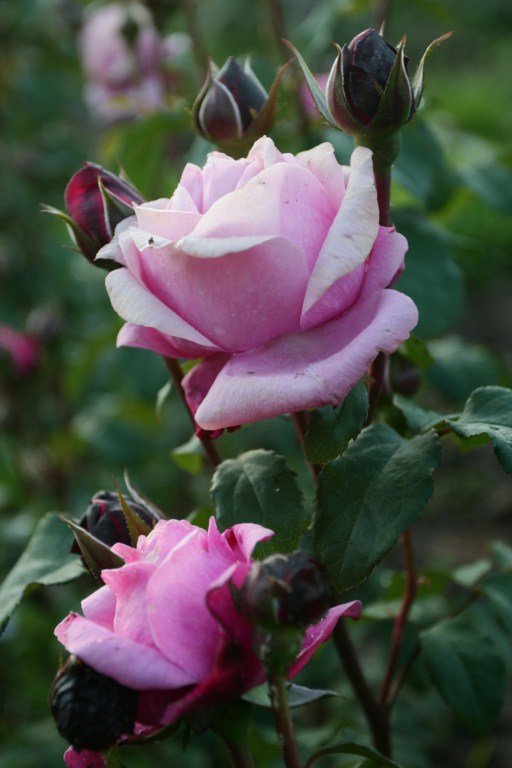
Soeur Emmanuelle (Delbard, 2004) has a very strong bouquet of aromas of anise, basil, dill, lavender and mango.
In the modern garden one cannot do without roses, which have an intense, very individual fragrance, consisting of originally combined olfactory tones. Volatile or more resistant, floral and forestry, these tones leave an unforgettable mark. Some of them went down in the history of rose growing, left a fragrant trail in perfumery and remain in our memory.
Unforgettable Aromas of the Last Century
‘ Dioressence’ (Delbard, 1974)
"DoubleDelight" (Ellis & Sweem, 1976 )
‘Yves Piaget’ (Meilland, 1984).
Valencia (W.Kordes "Sohne, 1989)
"The Mac Cartney Rose"(Meilland, 1992).
‘Souvenir de Marcel Proust"(Delbard, 1993).
‘Frederic Mistral’ (Meilland, 1995)
‘ChartreusedeParme’ (Delbard, 1996)
"Souvenir de Louis Amade"(Delbard, 1998).
‘Caprice de Meilland’ (Meilland, 1999)
Modern aromas
‘Andre le Notre’ (Meilland, 2001)
‘Parole’ (W.Kordes "Sohne, 2001)
‘Botero’ (Meilland, 2003)
‘Senteur Royale’ (Rosen Tantau, 2004)
"Soeur Emmanuelle"(Delbard, 2004)
‘Beverly’ (W.Kordes "Sohne, 2007)
‘Line Renaud’ (Meilland, 2008)
‘Sweet Parole’ (W.Kordes "Sohne, 2010)
‘Johann Wolfgang Goethe’ (Rosen Tantau, 2010)
‘Grafin Diana’ (W. Cordes "Sohne, 2012)
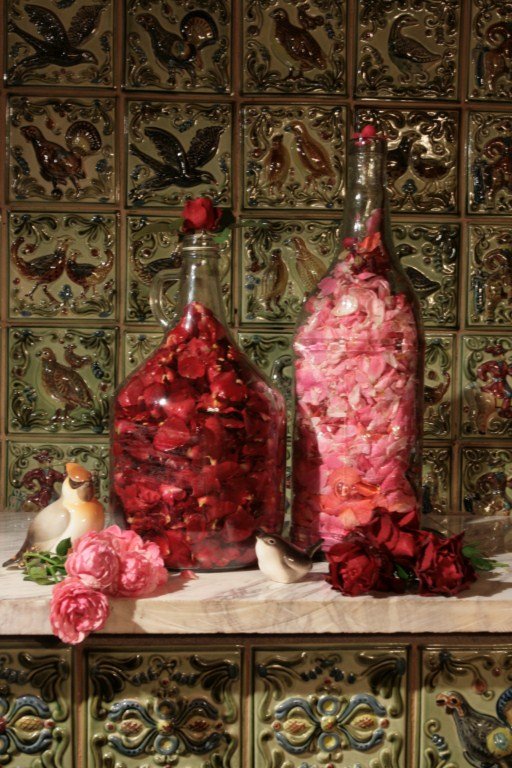
Aromatic blends.Rose petals are a good base for aromatic blends. In complete contradiction to the method of production of essential oil, when rose buds are harvested very early in the morning and immediately processed, rose petals for aromatic blends are collected during a sunny day, dried in the sun and then stored in an airtight container.
Gourmet drink.Petals of fragrant roses, not treated with chemical protective equipment, fill a bottle, pour vodka good quality, insist for 10–12 days (until the petals discolor). Drain the infusion (discard the petals without squeezing), let stand and use to prepare drinks of different strength and sugar content. You can repeat the procedure with fresh petals, but do not insist more than twice, it may appear too tart flavor. Boil sugar syrup (1 kg of sugar per 1000 ml of water), cool it to 40–50 hail. C and dilute the infusion at will, although a drink with a strength of 16–20 degrees is better perceived. You can use only one variety of roses, but it is better to take several varieties with different colors and different flavors. Instead of a bouquet of aromas, you will receive a bouquet of flavors. Your idea will be appreciated not only by gourmets.
The structure of the flower.

Stocks
Modern varieties of roses are usually grown not on their own roots (the so-called root-bearing roses), but they are grafted on wild-growing roses (rose hips) or varieties derived from them. As a stock, use the following plants:Rosa "Laxa" The most popular stock is reliable, tolerates transplant well, almost does not give shoots and has almost no thorns, which is convenient when grafting.
Rosa canina (dog rose) Gives the most hardy roses. As a stock, some varieties that grow well on heavy soils are used. Not particularly popular due to the abundance of tops.
Rosa multiflora (multi-flowered rose) Gives strong plants. Popular in the United States, in the UK is not common. Vaccinations take root poorly, the resulting plant may be short-lived.
Rosa rugosa (wrinkled rose) Sometimes used as a stock for standard roses. It is not recommended to plant bush roses on it, because it gives a lot of tops and does not grow well on heavy soils.
WAYS OF CULTIVATION

Roses are cultivated as ground cover plants or creepers, they form a bush or from them form a stab tree. Hybrid tea, patio roses, miniature roses, floribunda roses and shrub roses grow in the shape of a bush.
TYPES OF FLOWERS
The number of petals

Coloring
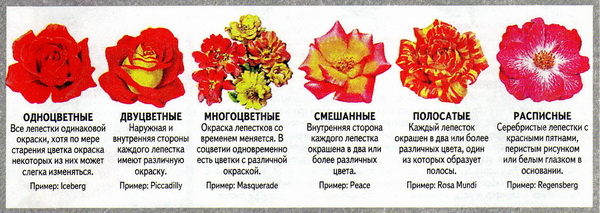
Petal shape
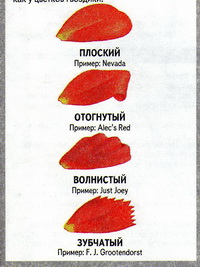
Many roses have flat petals, but some hybrid tea and floribunda roses are bent. Some varieties have petals with a wavy edge, in the variety J. J. Grootendorst, the petals are jagged along the edge, like those of carnation flowers.
Flower shape

TYPES OF LEAVES
Leaf surface
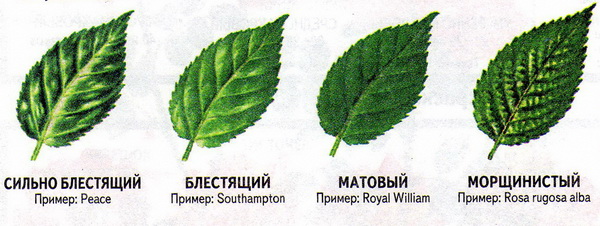
A typical rose leaf consists of five to seven smooth leaflets, the surface of which can reflect light to varying degrees. In some varieties of roses, the leaves shine so much as if rubbed with oil, the leaves of other varieties are almost dull. In addition to these two cases, there are many intermediate. Therefore, it is possible to distinguish between highly shiny, shiny and matte smooth leaves. Not all roses have a leaf with five or seven leaves - some, for example the variety Canary Bird, have beautiful pinnate leaves with more numerous leaves. The leaf surface is also not always smooth - the rose has wrinkled leaves with deep grooves.
Leaf color
![]()
Almost all adult leaves of the rose are green, from dim light green in the Fred Loads variety to dark green in the Felicia variety. The figures below show the three main types of leaves that differ in color - light green, green and dark green. Some varieties of roses have bronzing foliage with a characteristic copper tint.
There are exceptions to this rule. In shrub roses, young leaves are often purple or scarlet, and in some roses, for example, Rosa rubrifolia and Buff Beauty, adult leaves also retain red color. On the other hand, in white rose hybrids, leaves are bluish-green. Some roses, such as wrinkled roses, have exceptionally beautiful autumn leaves.
FLOWING PERIOD
In re-flowering roses during the season there are two or more flowering waves. Modern varieties of roses tend to bloom at intervals several times over the summer and even in the fall. This property explains the enduring popularity of hybrid tea and floribunda roses. Re-flowering, or, as they are called, long-flowering, or remontant, roses can also bloom in the intervals between the main flowering periods.In single-flowered roses, one wave of flowering usually lasts several weeks. In the fall, individual flowers may appear on them, but this is not considered to be repeated flowering. Most often, these roses bloom in summer, in June-July, although some varieties are shrub and climbing roses bloom in late spring, early summer or late summer.
FRUIT
After the flowers wither, some shrub roses adorn bright fleshy fruits. Fans of the well-known red bottle-shaped rose fruit Moyesii (Rosa moyesii) and large, similar to tomato, fruit varieties Frau Dagmar Hartopp. Fruits of other varieties come in a wide variety of shapes and colors.
AROMA
The fragrance is one of the virtues of a rose. In the descriptions of varieties of roses (pp. 12-90) for each variety it is indicated how strong its aroma is in its flowers, while the following grades are estimated: fragranceless, slightly fragrant, fragrant and very fragrant.However, it should be remembered that the assessment of smell depends on many conditions, including -
Personal taste: Some prefer heavy stupefying aromas, others like spicy or fruity.
Individual sensitivity: There are people who smell badly, but usually this defect, unlike deafness or visual impairment, does not manifest itself. Flower age: Flowers of some varieties of roses smell stronger at the beginning of flowering, others - when fully bloomed.
Weather: Flowers smell stronger in warm, wet weather.
The fragrance usually attaches to flowers, although some varieties of roses have fragrant leaves - see the description of the Lady Penzance variety.
According to the book of Dr. D.G. Hessayon "All about roses".
[email protected]

